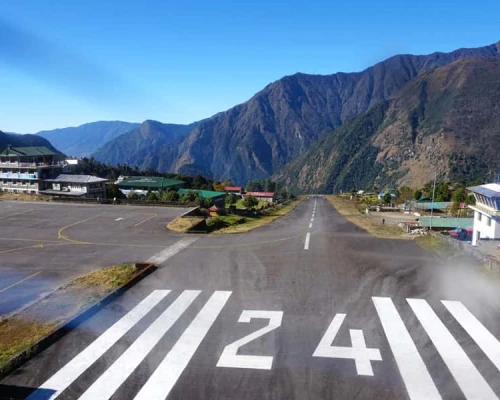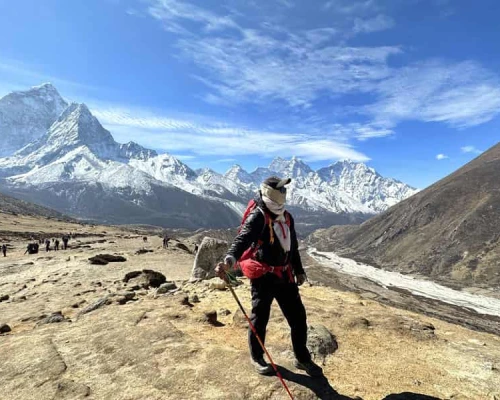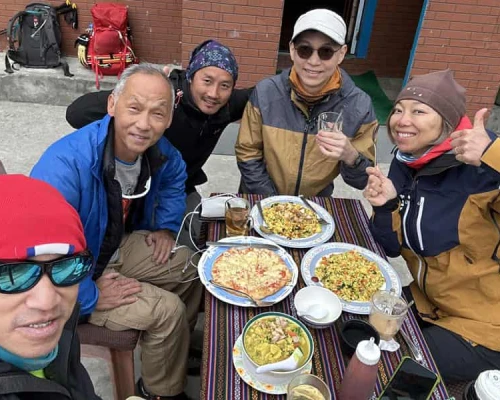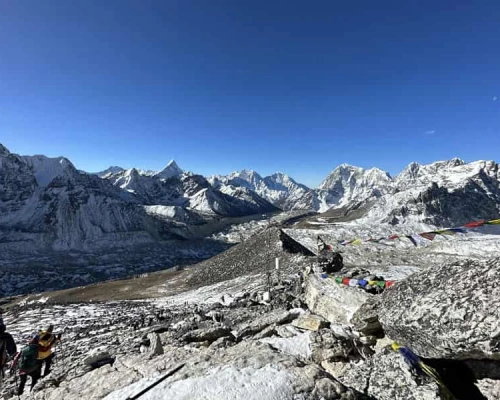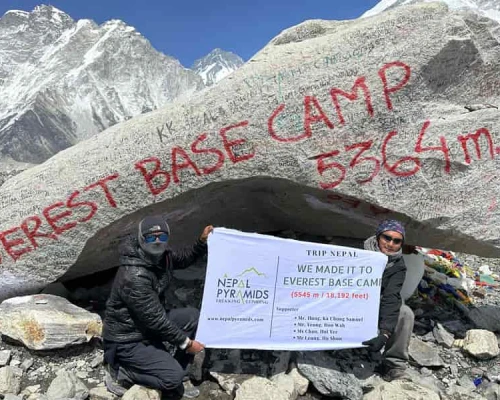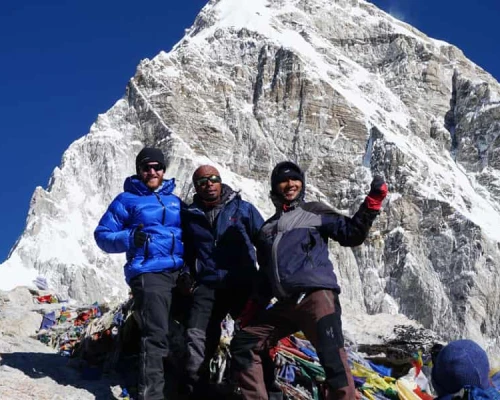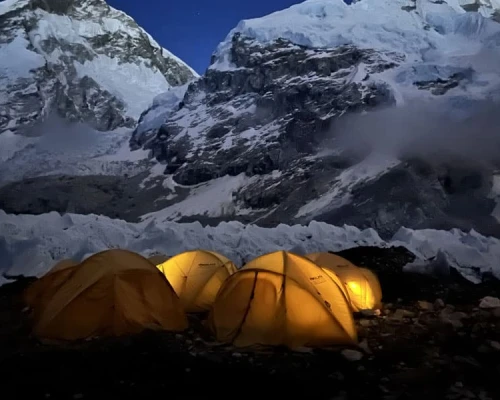EBC Trek with Sleeping at Everest Base Camp Trip Overview
The EBC Trek with Sleeping at Everest Base Camp is certainly an amazing opportunity that many people don't have the privilege to experience. This epic trek takes you into the legendary Khumbu Valley and allows you to follow in the footsteps of famous climbers. You will spend an unforgettable night camping at the symbolic Everest Base Camp.
Sleeping Overnight at Everest Base Camp is essentially experiencing the life of mountaineers who spend over a month living there while attempting Mount Everest.
Besides camping overnight at EBC, this trip will blend you in the rich culture and natural beauty of the high-altitude Sherpa villages. When you are at EBC, during the night time you will witness the sensational beauty of the surrounding peaks below the Milky Way in the captivating night sky. Sleeping at the base camp of the world’s highest mountain is a rare and profound experience.
Witnessing Everest at sunrise is an experience that will stay with you forever. In this epic EBC Trek with Sleeping at Everest Base Camp, days are filled with stunning Himalayan scenery and the warm hospitality of the hard-working Sherpas people. You will visit traditional Sherpa villages, and Buddhist monasteries and gain deeper insight into Tibetan Buddhism.
EBC Trek with Sleeping at Everest Base Camp Highlights
- Land at One of the World's Most Thrilling Airports in Lukla
- Traverse Vibrant Sherpa Villages like Namche Bazaar
- Cross Iconic Hillary Suspension Bridge
- Witness Breathtaking Views of Iconic Peaks
- Visit Ancient Tengboche Monastery & Feel Spiritual Power
- Trek Alongside the Immense Khumbu Glacier
- Reach Gorak Shep, on the Doorstep of Everest Base Camp
- Experience a Spectacular Himalayan Sunset
- Spend an Unforgettable Night Camping at Khumbu Glacier
- Gaze at the Glittering Night Sky in Tranquil Silence at EBC.
- Push Personal Limits Leaving with a Profound Sense of Achievement
Sleeping at Everest Base Camp Trip Summary
The EBC Trek with Sleeping at Everest Base Camp starts with a scenic flight from Kathmandu to Lukla. After spending some time in Lukla we will walk the Dudh Kosi River valley, through Sherpa Villages, Suspension bridges, and Tibetan-style settings. Gradually we reach Phakding for an overnight stay. Walking the legendary trails will eventually reach Namche Bazaar, the happening hub in the region. Namche Bazaar is the Administrative Center and the main trading center of the Khumbu region. It’s a luxury town with all the facilities. It’s like a mirage in the wilderness.
At Namche, we will spend two nights acclimatizing ourselves to a higher altitude. On our rest day, we will do the acclimatization hike to gain a certain elevation but sleep back at Namche teahouse. During your acclimatization exploration, you will have a chance to see the first glimpse of Everest and its neighboring mountains. In addition to this, you can also visit the local market, Namche museum, or monastery, or you can simply chill and explore the Bazaar.
Next, leaving the luxury town of Namche Bazaar we will continue our trek to to Phortse. Phortse happens to be one of the most picturesque settlements in the Khumbu Region. The village is also known as the ‘Terraced Town’ due to its terraced farming fields which is their heritage. As we leave Phortse and take the high mountain trekking trail we will have the most stunning view of iconic Ama Dablam, Thamserku, and Kangtega.
As we walk further we will have a gorgeous view of Mount Everest. Gradually we will reach the beautiful settlement of Dingboche, a village surrounded by stone walls and fields of barley and potatoes. At Dingboche, we have yet another acclimatization day to condition our bodies to thin air. As an acclimatization hike, we will hike to Nangkar Tshang Hill which also delivers the most panoramic view including Makalu, the 5th highest mountain in the world.
The next part of the trek will take you to Lobuche, a small settlement near the Khumbu Glacier. Now we will be more into the alpine region away from the tree line. We will walk the wider trail on the Himalayan meadow shortly starting from Dingboche. We will climb the Thugla Pass at (4830m) which in reality is a memorial dedicated to all the climbers who lost their lives on Everest and other surrounding peaks. As we trek further we will also see the peaks of Pumori, Lingtren, and Khumbutse. Progressively we reach Gorak Shep, the last village before Everest Base Camp. From Gorak Shep, we will hike to the Kala Patthar (5545m), the highest trekking point for the grandiose view.
Eventually, we will hike to eminent Everest Base Camp, the highlight of the trek. At EBC we will stay overnight in tented camps and hot drinks will be prepared by our staff. Tonight will be one of the most beautiful experiences of sleeping on the glacier and under the stars. It’s certainly a rare opportunity where we will genuinely experience the feeling of the Everest Climbers. This night is sure to become a memorable night under the stars, listening to the sounds of the glacier and the wind.
After spending a night at Everest Base Camp, you will retrace your steps back to Lukla via Tengboche Monastery.
Experience of Sleeping at Everest Base Camp
EBC Trek with Sleeping at Everest Base Camp is certainly a challenging trip. This trip demands both physical and mental endurance. However, the reward of spending a night in a tent under the stars at the iconic Everest Base Camp is an unbelievable experience.
After we are done with our hike to Kala Patthar we gradually make our way towards legendary Everest Base Camp through the glacier moraine trail. Our excitement and anticipation build with each step as we approach closer to our iconic destination.
Finally, when we reach the base of the world’s highest mountain, we will be greeted by a mesmeric view of majestic mountains that literally surrounds us from all sides. Spending a night at Everest Base Camp is a once-in-a-lifetime opportunity. This beautiful experience connects you with the invincible human aspiration that has appealed to millions for decades.
This Epic Trip is a memorable journey that will touch your soul and will remain with you forever. It is a memory that will craft your version of stories that may pass on to generations.
At Everest Base Camp, we will spend our night in a tent along with the delicious meal prepared by the locals. The towering mountains surround us like guardians and the sky gradually transforms into a ceiling adorned with glittering stars. The night experience here is indeed phenomenal which only few have the opportunity to experience. However, every now on then you will hear a rumbling of falling rocks over the crevasse since you are on the top of an active glacier.
Sleeping at Everest Base Camp is not just a mere adventure, it is a gift, a blessing, a miracle. You will certainly feel the magic of this place as you connect yourself with something bigger and more powerful than yourselves. Sleeping at Everest Base Camp is an experience you will never forget and it will be a memory you will always cherish.
NOTE:
However, it's important to note that sleeping at Everest Base Camp requires careful planning and preparation. The extreme altitude and harsh weather conditions demand proper acclimatization and the right equipment to ensure a safe and comfortable night's sleep. We consistently strive to offer our best by providing a skilled team and quality equipment to help you navigate challenges while offering expert guidance throughout the trek.
If you are a beginner climber and seeking to give it a go for your first 6000m peak in Nepal, CLICK HERE. Here we give you details on ideal peaks for beginners.
If you are looking for answers to the possibility of trekking to Everest Base Camp in December - CLICK HERE. Here we give you the details on what is it like at Everest Region all around the year - CHECK THIS OUT.


